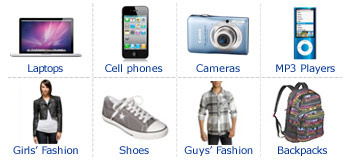AGRICULTURAL SCIENECE WAEC GCE 2021/2022 EXPO
-
AGRICULTURAL SCIENECE WAEC GCE 2021/2022 EXPO section A OBJECTIVES
1. The branch of agriculture that deal with structure and form of the
body is called...
Tweet Correct information on iPad at Work
Enterprises are adopting iPads faster than anyone
could have anticipated two short years ago. Why are
we talking about iPads and not tablets in general?
The answer is Apple absolutely dominates as the
tablet of choice in the enterprise. Good Technology
recently released its quarterly activation stats, and
iPads “dominated tablet activations for the quarter
with 97.3% of total tablet activations.” According to
Apple (Q2 2012 earnings call), iPads are in use
(testing, deploying, deployed) in 94% of the Fortune
500 and 75% of the Global 500. Frankly, clients don’t
ask us about Android tablets at this point, they ask us
about iPads.
As consumers, employees are embracing the device
for personal use, and quickly realizing that it can also
be a very useful business tool. Forward thinking IT
leaders are working with the business to identify use
cases; where can the device improve productivity,
streamline workflows, reduce costs, and even help
grow top line revenue? We often get the question,
“what are the use cases?” We can certainly help
identify some of the obvious use cases in certain job
roles and verticals, as identified in Info-Tech’s “ iPad
Hands On Review” of the original iPad in April, 2010:
Healthcare – for years hospitals and healthcare
facilities have tried to incorporate early generation
convertible tablets with resistive touchscreen displays
for bedside care. The 4-5 pound devices were heavy,
the resistive touchscreens required a stylus, the touch
capabilities of the operating systems were abysmal,
the batteries lasted two hours, and doctors and
nurses hated them. Most hospitals already use Citrix,
so they are used to deliver applications through a
virtual/presentation server. Everything changes when
you can deliver the necessary applications to a 1.5
pound tablet with a capacitive multi-touch display
and ten hours of battery life.
Education – Students currently pay a lot of money
for text books that are very heavy to carry around –
back strain from carrying 20+ pound backpacks is
common. The books kill a lot of trees and cost a lot to
manufacture. The era of the bound, paper text book
is nearing an end. If it’s not a multi-function tablet
device like the iPad, it will be an e-book reader like
the Kindle. The Kindle has some advantages on this
front, but what it’s missing is the multi-function part.
Students can use a multi-function tablet to connect to
the Student Information System, do research online,
communicate and collaborate, and view video
lectures. This type of device will almost certainly find
a place in higher education.
Professional services – Consider real estate
agents using this device to research and view
properties in real time with their clients while
travelling in desired areas. There are several
situations where opening and booting a laptop is not
ideal, but carrying a 1.5 pound, instant-on device
with a 9.7 inch display and WWAN
connectivity would be ideal.
Field services – The possibilities are endless for
this role. All service manuals can be stored and kept
current on the device. The field service application
can be live so the technician can immediately enter
information on the service call, then be routed to the
next call immediately and efficiently. How about an
insurance adjuster or a building inspector?
Retail – This class of device quickly and easily
becomes a mobile POS terminal. Rather than
customers queuing up at cash registers, store
associates can go to the customer, assist them, and
accept payment without the customer ever standing
in a line. If you’ve never been to an Apple store, they
do exactly this. They use iPod Touch’s for mobile POS
terminals, and there is not a queue to pay anywhere
in the store.
The use cases have obviously evolved significantly,
and we are no longer looking at the iPad as a
consumption-only device. Content creation is
certainly viable, particularly when a keyboard is
paired with the device. Rather than try to identify all
of the potential use cases, it makes more sense to
determine the viability of different tasks and
activities. In short, what it does really well, what it
can do in a pinch, and what it simply can’t do.
The iPad is ideal for:
Consuming content of pretty much any kind.
Reading, listening to audio, viewing images, watching
video, Web browsing – virtually any type of content.
Personal Information Management (PIM),
including email, contacts, and calendaring. With
Exchange ActiveSync integration, it’s ideal for
organizations that use Microsoft Exchange, but also
works very well with virtually every other platform.
Personal document/notebook management
and note taking/organizing using apps like Evernote
or OneNote. These apps are ideal for organizing
notes, documents, to-do lists, etc.
Communicating and collaborating using
enterprise Unified Communications (UC), video/web
conferencing, social networking, and Enterprise
Content Management (ECM) systems, or using any of
the countless consumer-grade apps.
Using Web-based (non-Flash) mobile-
optimized enterprise applications and forms.
Using native (developed for iOS) enterprise
applications , such as CRM, ERP, BI, ECM, etc.
Securely connecting to business resources and
applications through secure Wi-Fi or VPN over
3G/4G networks.
The iPad will do in a pinch:
Document creation and editing. The biggest
challenge here is compatibility with Microsoft Office.
If you use Apple’s iWork suite or Google Docs in the
enterprise, you can move this up to the previous
section. If you use Microsoft Office (most do), none of
the currently available word processing, spreadsheet,
and presentation apps or suites available for the iPad
(including Apple’s own iWork apps) have perfect
compatibility. Most work pretty well with simple
documents, spreadsheets, and presentations, but
fidelity is often lost with more complex files. There
are also features missing, like commenting and
tracking changes. It is widely rumored that Microsoft
will release a version of Office for the iPad soon, but
unless/until that happens, the compatibility
challenge remains for native apps. However, there is a
free office app called CloudOn that delivers native
Microsoft Office apps through application
virtualization. It works well, but requires Internet
connectivity.
Accessing non-native, non-Web enterprise
applications . Thick client enterprise applications
that run on Windows will obviously not run natively
on the iPad. However, application virtualization can
make those applications accessible on the iPad even if
they don’t run natively. The most common solution is
Citrix XenApp on the back end, and Citrix Receiver
on the iPad. The applications are published in
XenApp and actually run in the data center, while
Citrix Receiver runs on the iPad and accesses the
applications running in the data center. VMWare
View is another option, and new solutions from
VMWare, including Horizon Application Manager,
look compelling. Finally, there is the option of using
an RDP client on the iPad to access a personal
desktop. There are countless RDP clients available,
but solutions like Citrix GoToMyPC and LogMeIn
allow multiple simultaneous connections through the
firewall. It’s notable that the user experience with
these solutions is not great. Windows applications are
not “touch-friendly”, so navigation is less than ideal.
File Management. Local file management is out –
iOS does not allow file-level access through a file
manager. Files live in their native applications (i.e.
presentation files are stored in Keynote), but you
can’t see all of your files in one place natively on the
device. However, there are several options for file
management in the cloud (public or private),
including Dropbox, Box, Druva, Google Drive,
SharePlus (SharePoint access), and VMWare’s
project Octopus (currently in beta). The problem has
been around security and data leakage – particularly
concerning with Dropbox. Many of the solutions, like
Box, are enterprise manageable and should be
encouraged (or mandated) instead of Dropbox for
sensitive company documents.
Presenting or demonstrating. Passing an iPad
back and forth is not an ideal presentation technique,
particularly for large groups. There are adapters that
connect to the Apple 30 pin connection and push out
VGA, HDMI, or even composite connections. These
adapters work very well connecting to projectors and
the iPad display can be mirrored on at television or
big screen. If an Apple TV is connected to a television
or projector, Apple AirPlay allows you to wirelessly
mirror the iPad screen through the Apple TV on to
the big screen. There are options for getting the
presentation material from your iPad to the big
screen, but it’s not a native capability in that it
requires an adapter or Apple TV.
Printing. It is possible to print wirelessly from an
iPad, but it can be problematic. If the target printer
is wireless, it’s pretty straightforward. But most
enterprise environments have network connected
print servers and printers that require the printing
device to be authenticated on the domain. Apps exist
that will push the print job to a PC or Mac and then
to the printer, but you have to be on the same
wireless network. The bottom line is that it is possible
to print from an iPad in some cases, but it’s not
always possible or practical on an enterprise network.
The iPad won’t do it:
Adobe Flash. Apple said it would not support Flash
when the first iPad was released two years ago. Much
discussion and debate followed, causing Steve Jobs to
personally write a note to customers explaining
Apple’s position. Two short years ago, the Web was
Flash. But Apple made a big bet on HTML 5, and it
was a good bet. Over the course of the past two years,
the ubiquity of Flash is gone. YouTube even
transcoded much of its library to H.264 (the video
format for HTML 5), and most Websites have either
converted to HTML 5, or built mobile versions
without Flash. There are options, like the Skyfire
browser for iOS, that will convert Flash on the fly and
stream H.264 video back to the browser, but to say
it’s clunky and unintuitive would be an
understatement.
Connect to USB peripherals. If you want to
connect a USB peripheral, forget about it. There are
no USB ports on an iPad, and while there are some
adapters available (i.e. video adapters and an iPad
docking keyboard), native USB support is out.
Connect a mouse. You can’t connect a mouse to an
iPad unless it is jailbroken. While Apple does support
the use of some Bluetooth peripherals (including
keyboards) it does not support the use of a mouse on
the iPad.
Transfer content to mass storage devices.
Without USB ports or an SD card slot, it is not
possible to move files from the iPad to a mass storage
device. The exception is connecting to a PC or Mac
with the Apple to USB cable to transfer photos and
video. Also, files can be loaded on the devices through
iTunes, but simply moving content to a USB flash
drive or SD card is out.
It should be noted that it is possible for enterprise IT
to manage iPads. Apple has a robust Mobile Device
Management (MDM) API that allows very granular
management and control. Have a look at Info-Tech’s
“ Vendor Landscape: Mobile Device Management
Suites” for more information on MDM solutions.
Let us know if you think we’ve missed anything.
CATHEGORIES
INFORMATIONS,
IPAD iTUNES,
iPHONE,
TUTORIALS
Subscribe to:
Post Comments (Atom)
SHOP & BUY AT REDUCED RATES FROM ANYWHERE CALL +2347030722911














0 comments:
Post a Comment
Sign-in to comment
Note: Only a member of this blog may post a comment.